
Mortellaro's Nursery
Shrubs, trees, ground covers, native plants, and seasonal color
Wholesale Only
Click on any of the alpha indexes below to view the corresponding lists of plants.
The default list is displayed alphabetically by common name for all plant types. You can view the plants by clicking on the Scientific Name or limit the plant type by using the drop down.
Plants actively being grown for the current season are shown -- selecting Discontinued Items will show plants we have offered in the past.
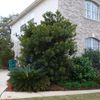
|
Japanese Blueberry ShrubBotanical Name: Elaeocarpus decipiens
Japanese Blueberry Tree is a broadleaf evergreen that brings a lush, structured element to Texas landscapes. While it can reach 40 feet tall and 20 feet wide in tropical climates, in most of Texas, it typically grows 20 to 30 feet tall and 15 to 20 feet wide. Its dense, dark green foliage takes on a copper-red hue in new growth, adding year-round visual interest. The tree produces small, inconspicuous white flowers in spring, followed by deep blue, olive-like fruit that attracts birds but can be messy if planted near walkways. In Texas, cold hardiness is a key consideration. While it thrives in USDA Zones 8-11, it may suffer damage in prolonged freezes below 15°F. In North Texas and the Panhandle, it may not be a reliable choice due to occasional extreme cold, whereas it performs well in Central-South and Coastal Texas. If planted in areas prone to freezing, it benefits from a wind-protected location, such as near buildings or in courtyards, to shield it from harsh winter conditions. Japanese Blueberry prefers well-draining, slightly acidic to neutral soils but can tolerate alkalinity. It grows best in full sun to partial shade. It is drought-tolerant once established but benefits from occasional deep watering in dry periods. Regular pruning can help maintain a symmetrical shape and remove lower branches if grown as a tree instead of a shrub. For planting as a screen or hedge, space trees 8 to 12 feet apart to allow for proper root development and canopy spread. While it can be used as a focal point or shade tree, its tendency to drop fruit and older leaves makes it less suitable for poolside plantings or patios. Winter Care: In areas prone to frost, mulching around the base can help insulate roots, and wrapping young trees in frost cloth during extreme cold events may prevent dieback. If minor cold damage occurs, pruning in early spring will encourage healthy regrowth. [ More Info ]
|
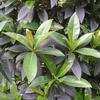
|
Japanese Blueberry Tree - Tree FormBotanical Name: Elaeocarpus decipiens
Japanese Blueberry Tree is a broadleaf evergreen that brings a lush, structured element to Texas landscapes. While it can reach 40 feet tall and 20 feet wide in tropical climates, in most of Texas, it typically grows 20 to 30 feet tall and 15 to 20 feet wide. Its dense, dark green foliage takes on a copper-red hue in new growth, adding year-round visual interest. The tree produces small, inconspicuous white flowers in spring, followed by deep blue, olive-like fruit that attracts birds but can be messy if planted near walkways. In Texas, cold hardiness is a key consideration. While it thrives in USDA Zones 8-11, it may suffer damage in prolonged freezes below 15°F. In North Texas and the Panhandle, it may not be a reliable choice due to occasional extreme cold, whereas it performs well in Central-South and Coastal Texas. If planted in areas prone to freezing, it benefits from a wind-protected location, such as near buildings or in courtyards, to shield it from harsh winter conditions. Japanese Blueberry prefers well-draining, slightly acidic to neutral soils but can tolerate alkalinity. It grows best in full sun to partial shade. It is drought-tolerant once established but benefits from occasional deep watering in dry periods. Regular pruning can help maintain a symmetrical shape and remove lower branches if grown as a tree instead of a shrub. For planting as a screen or hedge, space trees 8 to 12 feet apart to allow for proper root development and canopy spread. While it can be used as a focal point or shade tree, its tendency to drop fruit and older leaves makes it less suitable for poolside plantings or patios. Winter Care: In areas prone to frost, mulching around the base can help insulate roots, and wrapping young trees in frost cloth during extreme cold events may prevent dieback. If minor cold damage occurs, pruning in early spring will encourage healthy regrowth. [ More Info ]
|
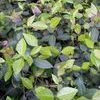
|
Jasmine, AsianBotanical Name: Trachelospermum asiaticum
Contrary to the name, this is not a true Jasmine. Native to Asia, it has become widespread in the landscape as it is the most common choice when it comes to ground covers.
Fast and vigorous growing, this evergreen tolerates heat and adverse conditions with no real pest issues. It will prefer and perform better in rich well-drained soils, but is drought tolerant once established. Spreads easily as the stems sprout roots when coming into contact with the ground, and often gets thick enough to prevent most weeds from growing.
Although many other sources claim there are yellow and highly fragrant blooms, it's rare to see in Texas.
[ More Info ]
|
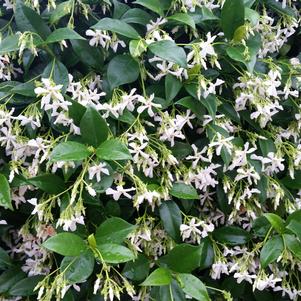
|
Jasmine, ConfederateBotanical Name: Trachelospermum jasminoides
Confederate Jasmine (Trachelospermum jasminoides) is a vigorous, evergreen vine appreciated for its fragrant white star-shaped flowers and glossy, dark green foliage. This popular climbing vine is often used in trellises, fences, arbors, and as a ground cover, bringing a classic, southern charm to landscapes. Its blooms appear heavily in late spring to early summer, filling the garden with a sweet, jasmine-like fragrance. Confederate Jasmine thrives in full sun to partial shade and prefers well-drained, moderately fertile soils. It is adaptable to both acidic and alkaline soils but performs best when planted in soil with good drainage. Once established, it is moderately drought tolerant but benefits from regular watering during extended dry periods. The plant is deer resistant and is relatively free of major pests and diseases. This vine can reach up to 20 feet in length when supported or used as a groundcover, spreading 6-10 feet wide. For best performance, space plants 3-5 feet apart if planting along fences or trellises. Confederate Jasmine provides dense, evergreen coverage, making it ideal for creating living screens or softening structures. In USDA Zones 8-10, Confederate Jasmine is cold-hardy but may experience leaf damage during hard freezes. In colder regions of Texas, it is best planted in protected locations, such as against south-facing walls or under tree canopies. Applying mulch to the base in winter can also help insulate the roots. [ More Info ]
|
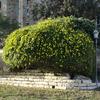
|
Jasmine, PrimroseBotanical Name: Jasminum mesnyi
Primrose Jasmine is a fast-growing, semi-evergreen shrub with a sprawling habit, often used as a cascading groundcover or trained over fences and walls. This vigorous plant produces bright yellow, lightly fragrant, semi-double flowers in late winter to early spring, making it one of the earliest bloomers in Texas landscapes. It thrives in full sun to partial shade and prefers well-draining soil but is adaptable to various conditions. While not a Texas native, it performs well in many regions, especially in Central and South Texas, where winter temperatures remain mild. This jasmine species is an excellent choice for erosion control on slopes or banks, thanks to its arching canes that root where they touch the ground. It can also be used as a loose, informal hedge, though it requires occasional pruning to maintain shape. It normally grows 6 to 10 feet tall, and 4 to 7 feet wide. Space them 4 to 6 feet apart for an uniformed hedge. Due to its aggressive growth, regular trimming helps prevent it from overtaking surrounding plants. Primrose Jasmine is not considered toxic to pets or humans, making it a safe option for family-friendly gardens. Compared to the more common Carolina Jessamine (Gelsemium sempervirens), which has a similar vining habit and yellow flowers, Primrose Jasmine is a shrub rather than a true vine. Unlike Carolina Jessamine, which has toxic properties, Primrose Jasmine is safe to plant in areas frequented by pets and children. However, it lacks the strong fragrance associated with some jasmine species, so it is chosen more for its ornamental value than for scent. In areas with harsh winters, Primrose Jasmine may experience dieback, but it generally rebounds in spring. In North Texas, it benefits from planting in a protected location, such as against a south-facing wall, to shield it from cold winds. While it can tolerate occasional freezing temperatures, prolonged hard freezes may damage the plant. A layer of mulch around the base can help insulate the roots in winter. [ More Info ]
|
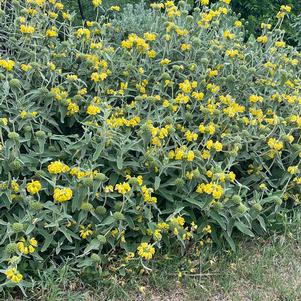
|
Jerusalem SageBotanical Name: Phlomis fruticosa
Jerusalem Sage is a drought-tolerant, evergreen shrub native to the Mediterranean, prized for its soft, woolly gray-green foliage and whorls of bright yellow, tubular flowers that appear in late spring to early summer. Though not a true sage, it shares many traits with salvias, including strong heat tolerance and low water needs, making it well-suited for Central and West Texas landscapes. The flowers attract bees and butterflies, adding ecological value to xeric garden designs. This plant thrives in full sun and prefers well-drained, alkaline or neutral soils. It is highly deer-resistant, thanks to its aromatic foliage, and performs well in rock gardens, dry borders, Mediterranean-style landscapes, or mass plantings. Once established, it requires minimal irrigation. While not ideal for poorly drained or heavy clay soils, it can thrive on slopes or raised beds where drainage is better. Jerusalem Sage grows to about 3 to 4 feet tall and wide. When planting in groups, space plants 3 to 4 feet apart to allow for air circulation and growth. Though technically evergreen in mild winters, foliage may suffer cosmetic damage in hard freezes, especially in USDA Zones 7 and lower. In colder regions of Texas, it benefits from mulching around the base in winter and light pruning in early spring to remove any frost-damaged stems and encourage bushier growth. [ More Info ]
|
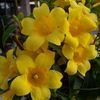
|
Jessamine, CarolinaBotanical Name: Gelsemium sempervirens
Carolina Jessamine (Gelsemium sempervirens) is a fast-growing, evergreen vine native to the southeastern U.S., including Texas. Despite its common name, it is not a true jasmine, those being in the Jasminum species. It produces bright yellow, trumpet-shaped flowers in late winter, adding vibrant color to fences, trellises, and arbors. This vine is highly adaptable, tolerating both acidic and alkaline soils, as well as periods of drought once established. It prefers well-draining soil but can handle occasional wet conditions. This plant is an excellent choice for Texas landscapes due to its heat and cold tolerance. It remains evergreen in milder winters but may lose some foliage in colder regions. While deer generally avoid it, it is important to note that all parts of Gelsemium sempervirens are toxic if ingested, making it unsuitable for areas where livestock or curious pets might graze. Mature plants reach 10-20 feet long and can spread 3-6 feet wide, depending on support structures. When planting multiple vines, spacing 4-6 feet apart is recommended. Carolina Jessamine is a low-maintenance option that provides year-round interest with its glossy foliage and seasonal floral display. [ More Info ]
|

|
Julia Child RoseBotanical Name: Rosa x 'Julia Child'
Highly disease resistant rose with golden double blooms with a licorice candy fragrance. Consistent bloomer, often with multiple flowers in tight clusters. The deep green foliage makes a striking contrast. Matures at three feet tall and wide, very low maintenance, making it an ideal choice for any landscape. [ More Info ]
|
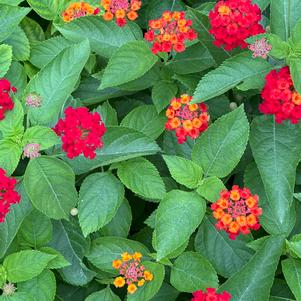
|
Lantana, Bandolista Red ChiliBotanical Name: Lantana sp. 'Red Chili'
Lantana (Lantana camara) is a vigorous, bushy perennial that adds vibrant color to Texas landscapes with its clusters of bright flowers. This heat-loving plant thrives in USDA Zones 8 through 11 and performs best in full sun. Lantana tolerates a wide range of soil types (alkaline or acidic), preferring well-drained soils, and is highly drought-tolerant once established. While not a Texas native (That one is Lantana aurticoides), its resilience and adaptability make it an excellent choice for gardens across the state. The eye-catching flowers bloom from spring until the first frost, attracting pollinators such as bees, butterflies, and hummingbirds. Lantana is also deer-resistant, as its aromatic foliage deters browsing. However, it’s important to note that all parts of the plant, especially the berries, are toxic if ingested, making it unsuitable for areas frequented by pets or young children. Space plants 3 to 5 feet apart to allow for their mature size and encourage proper airflow. "Bandolista Red Chili" is best described as a compact or ground cover "Radiation Lantana", as blooms start in shades of yellow and orange, but finish to be dark red. It only grows 3 to 4 feet tall and wide, but keeps a very tight habit and does not require much pruning if any to keep the tight shape. Lantana is versatile in the landscape, serving as a colorful focal point, a low-maintenance barrier hedge, or a bold addition to mixed perennial beds. This cultivar is well-suited to the intense afternoon heat of Texas and is an excellent choice for xeriscaping or other water-wise gardening practices. During winter, Lantana may die back to the ground in areas with hard freezes but typically regrows in spring. To maintain its shape and encourage new growth, prune back any dead wood in late winter or early spring. Applying a light layer of mulch around the base can help protect the roots in colder regions. [ More Info ]
|
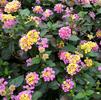
|
Lantana, ConfettiBotanical Name: Lantana sp.
Lantana (Lantana camara) is a vigorous, bushy perennial that adds vibrant color to Texas landscapes with its clusters of bright flowers. This heat-loving plant thrives in USDA Zones 8 through 11 and performs best in full sun. Lantana tolerates a wide range of soil types (alkaline or acidic), preferring well-drained soils, and is highly drought-tolerant once established. While not a Texas native (That one is Lantana aurticoides), its resilience and adaptability make it an excellent choice for gardens across the state. The eye-catching flowers bloom from spring until the first frost, attracting pollinators such as bees, butterflies, and hummingbirds. Lantana is also deer-resistant, as its aromatic foliage deters browsing. However, it’s important to note that all parts of the plant, especially the berries, are toxic if ingested, making it unsuitable for areas frequented by pets or young children. Space plants 3 to 5 feet apart to allow for their mature size and encourage proper airflow. Confetti Displays multicolored blooms transitioning through shades of yellow, pink, and purple. It typically reaches 2 to 3 feet tall and spreads 3 to 5 feet, suiting it for mixed borders or mass plantings. Lantana is versatile in the landscape, serving as a colorful focal point, a low-maintenance barrier hedge, or a bold addition to mixed perennial beds. This cultivar is well-suited to the intense afternoon heat of Texas and is an excellent choice for xeriscaping or other water-wise gardening practices. During winter, Lantana may die back to the ground in areas with hard freezes but typically regrows in spring. To maintain its shape and encourage new growth, prune back any dead wood in late winter or early spring. Applying a light layer of mulch around the base can help protect the roots in colder regions. [ More Info ]
|

|
Lantana, Dallas RedBotanical Name: Lantana sp.
Lantana (Lantana camara) is a vigorous, bushy perennial that adds vibrant color to Texas landscapes with its clusters of bright flowers. This heat-loving plant thrives in USDA Zones 8 through 11 and performs best in full sun. Lantana tolerates a wide range of soil types (alkaline or acidic), preferring well-drained soils, and is highly drought-tolerant once established. While not a Texas native (That one is Lantana aurticoides), its resilience and adaptability make it an excellent choice for gardens across the state. The eye-catching flowers bloom from spring until the first frost, attracting pollinators such as bees, butterflies, and hummingbirds. Lantana is also deer-resistant, as its aromatic foliage deters browsing. However, it’s important to note that all parts of the plant, especially the berries, are toxic if ingested, making it unsuitable for areas frequented by pets or young children. Space plants 3 to 5 feet apart to allow for their mature size and encourage proper airflow. Dallas Red features striking clusters of fiery red and orange flowers. This cultivar grows 3 to 5 feet tall and spreads 4 to 6 feet, making it ideal for larger spaces or as a focal point. Lantana is versatile in the landscape, serving as a colorful focal point, a low-maintenance barrier hedge, or a bold addition to mixed perennial beds. This cultivar is well-suited to the intense afternoon heat of Texas and is an excellent choice for xeriscaping or other water-wise gardening practices. During winter, Lantana may die back to the ground in areas with hard freezes but typically regrows in spring. To maintain its shape and encourage new growth, prune back any dead wood in late winter or early spring. Applying a light layer of mulch around the base can help protect the roots in colder regions. [ More Info ]
|
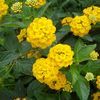
|
Lantana, GoldBotanical Name: Lantana sp.
Low-growing, spreading Lantana varieties in Gold, Purple, and White are herbaceous perennials that serve as versatile groundcovers in Texas landscapes. Reaching a mature height of 12 to 24 inches and spreading 4 to 6 feet wide, they provide excellent ground coverage. Thriving in full sun, they perform exceptionally well in hot and dry conditions, making them ideal for central, south, and coastal Texas. They tolerate a wide range of soil types, including poor, sandy, or rocky soils, but they need good drainage to prevent root rot. These varieties are highly drought-tolerant once established and flourish with minimal maintenance, showcasing vibrant blooms from spring through fall. These Lantana varieties are an excellent choice for erosion control on slopes, as a ground cover, or in mass plantings where a splash of consistent color is desired. Their spreading habit makes them ideal for borders or cascading over retaining walls. While they are deer-resistant and attract pollinators like butterflies and bees, some parts of the plant can be toxic if ingested, so care should be taken in landscapes with pets or small children. In areas prone to freezes, these Lantana varieties may die back to the ground in winter but often regrow from the roots in spring. To protect plants during a hard freeze, add a layer of mulch around the base to insulate the roots, and prune back dead growth once the risk of frost has passed. Their reliability, vibrant color, and adaptability make them a favorite for adding texture and beauty to Texas landscapes. [ More Info ]
|
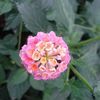
|
Lantana, IreneBotanical Name: Lantana sp.
Lantana (Lantana camara) is a vigorous, bushy perennial that adds vibrant color to Texas landscapes with its clusters of bright flowers. This heat-loving plant thrives in USDA Zones 8 through 11 and performs best in full sun. Lantana tolerates a wide range of soil types (alkaline or acidic), preferring well-drained soils, and is highly drought-tolerant once established. While not a Texas native (That one is Lantana aurticoides), its resilience and adaptability make it an excellent choice for gardens across the state. The eye-catching flowers bloom from spring until the first frost, attracting pollinators such as bees, butterflies, and hummingbirds. Lantana is also deer-resistant, as its aromatic foliage deters browsing. However, it’s important to note that all parts of the plant, especially the berries, are toxic if ingested, making it unsuitable for areas frequented by pets or young children. Space plants 3 to 5 feet apart to allow for their mature size and encourage proper airflow. Ierene Lantana has vibrant lavender-purple flowers with yellow centers, keeping a height of 2 feet tall but 4 feet wide. Lantana is versatile in the landscape, serving as a colorful focal point, a low-maintenance barrier hedge, or a bold addition to mixed perennial beds. This cultivar is well-suited to the intense afternoon heat of Texas and is an excellent choice for xeriscaping or other water-wise gardening practices. During winter, Lantana may die back to the ground in areas with hard freezes but typically regrows in spring. To maintain its shape and encourage new growth, prune back any dead wood in late winter or early spring. Applying a light layer of mulch around the base can help protect the roots in colder regions. [ More Info ]
|
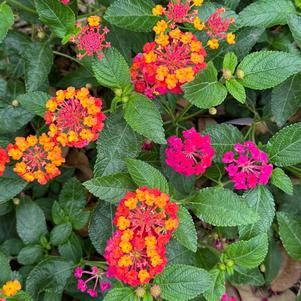
|
Lantana, Passion FruitBotanical Name: Lantana sp. 'Passion Fruit'
Lantana (Lantana camara) is a vigorous, bushy perennial that adds vibrant color to Texas landscapes with its clusters of bright flowers. This heat-loving plant thrives in USDA Zones 8 through 11 and performs best in full sun. Lantana tolerates a wide range of soil types (alkaline or acidic), preferring well-drained soils, and is highly drought-tolerant once established. While not a Texas native (That one is Lantana aurticoides), its resilience and adaptability make it an excellent choice for gardens across the state. The eye-catching flowers bloom from spring until the first frost, attracting pollinators such as bees, butterflies, and hummingbirds. Lantana is also deer-resistant, as its aromatic foliage deters browsing. However, it’s important to note that all parts of the plant, especially the berries, are toxic if ingested, making it unsuitable for areas frequented by pets or young children. Space plants 3 to 5 feet apart to allow for their mature size and encourage proper airflow. Passion Fruit offers vibrant purple and magenta flowers, and only grows 3 to 4 feet in height and 4 to 5 feet wide. Unlike Confetti or Irene Lantana, it seems to keep a tighter growth habit. Lantana is versatile in the landscape, serving as a colorful focal point, a low-maintenance barrier hedge, or a bold addition to mixed perennial beds. This cultivar is well-suited to the intense afternoon heat of Texas and is an excellent choice for xeriscaping or other water-wise gardening practices. During winter, Lantana may die back to the ground in areas with hard freezes but typically regrows in spring. To maintain its shape and encourage new growth, prune back any dead wood in late winter or early spring. Applying a light layer of mulch around the base can help protect the roots in colder regions. [ More Info ]
|
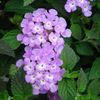
|
Lantana, PurpleBotanical Name: Lantana sp.
Low-growing, spreading Lantana varieties in Gold, Purple, and White are herbaceous perennials that serve as versatile groundcovers in Texas landscapes. Reaching a mature height of 12 to 24 inches and spreading 4 to 6 feet wide, they provide excellent ground coverage. Thriving in full sun, they perform exceptionally well in hot and dry conditions, making them ideal for central, south, and coastal Texas. They tolerate a wide range of soil types, including poor, sandy, or rocky soils, but they need good drainage to prevent root rot. These varieties are highly drought-tolerant once established and flourish with minimal maintenance, showcasing vibrant blooms from spring through fall. These Lantana varieties are an excellent choice for erosion control on slopes, as a ground cover, or in mass plantings where a splash of consistent color is desired. Their spreading habit makes them ideal for borders or cascading over retaining walls. While they are deer-resistant and attract pollinators like butterflies and bees, some parts of the plant can be toxic if ingested, so care should be taken in landscapes with pets or small children. In areas prone to freezes, these Lantana varieties may die back to the ground in winter but often regrow from the roots in spring. To protect plants during a hard freeze, add a layer of mulch around the base to insulate the roots, and prune back dead growth once the risk of frost has passed. Their reliability, vibrant color, and adaptability make them a favorite for adding texture and beauty to Texas landscapes. [ More Info ]
|
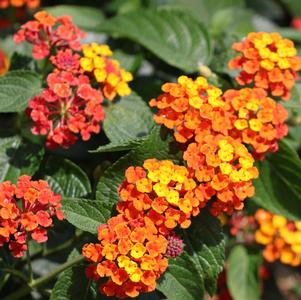
|
Lantana, RadiationBotanical Name: Lantana sp.
Lantana (Lantana camara) is a vigorous, bushy perennial that adds vibrant color to Texas landscapes with its clusters of bright flowers. This heat-loving plant thrives in USDA Zones 8 through 11 and performs best in full sun. Lantana tolerates a wide range of soil types (alkaline or acidic), preferring well-drained soils, and is highly drought-tolerant once established. While not a Texas native (That one is Lantana aurticoides), its resilience and adaptability make it an excellent choice for gardens across the state. The eye-catching flowers bloom from spring until the first frost, attracting pollinators such as bees, butterflies, and hummingbirds. Lantana is also deer-resistant, as its aromatic foliage deters browsing. However, it’s important to note that all parts of the plant, especially the berries, are toxic if ingested, making it unsuitable for areas frequented by pets or young children. Space plants 3 to 5 feet apart to allow for their mature size and encourage proper airflow. Radiation Lantana has fiery orange and red blooms, and reaches heights of 4 feet tall and spreads up to 6 feet wide. Makes an excellent bold focal point due to the large size and vivid blooms. Lantana is versatile in the landscape, serving as a colorful focal point, a low-maintenance barrier hedge, or a bold addition to mixed perennial beds. This cultivar is well-suited to the intense afternoon heat of Texas and is an excellent choice for xeriscaping or other water-wise gardening practices. During winter, Lantana may die back to the ground in areas with hard freezes but typically regrows in spring. To maintain its shape and encourage new growth, prune back any dead wood in late winter or early spring. Applying a light layer of mulch around the base can help protect the roots in colder regions. [ More Info ]
|
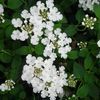
|
Lantana, WhiteBotanical Name: Lantana sp.
Low-growing, spreading Lantana varieties in Gold, Purple, and White are herbaceous perennials that serve as versatile groundcovers in Texas landscapes. Reaching a mature height of 12 to 24 inches and spreading 4 to 6 feet wide, they provide excellent ground coverage. Thriving in full sun, they perform exceptionally well in hot and dry conditions, making them ideal for central, south, and coastal Texas. They tolerate a wide range of soil types, including poor, sandy, or rocky soils, but they need good drainage to prevent root rot. These varieties are highly drought-tolerant once established and flourish with minimal maintenance, showcasing vibrant blooms from spring through fall. These Lantana varieties are an excellent choice for erosion control on slopes, as a ground cover, or in mass plantings where a splash of consistent color is desired. Their spreading habit makes them ideal for borders or cascading over retaining walls. While they are deer-resistant and attract pollinators like butterflies and bees, some parts of the plant can be toxic if ingested, so care should be taken in landscapes with pets or small children. In areas prone to freezes, these Lantana varieties may die back to the ground in winter but often regrow from the roots in spring. To protect plants during a hard freeze, add a layer of mulch around the base to insulate the roots, and prune back dead growth once the risk of frost has passed. Their reliability, vibrant color, and adaptability make them a favorite for adding texture and beauty to Texas landscapes. [ More Info ]
|
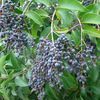
|
Ligustrum, JapaneseBotanical Name: Ligustrum lucidum
Japanese Ligustrum, also known as Japanese Privet and Glossy Privet, is a fast-growing evergreen tree often used as a large hedge, screen, or small ornamental tree. It thrives in Texas landscapes, particularly in urban settings, due to its tolerance for poor soils, pollution, and drought once established. This adaptable species can handle a variety of soil types, including both alkaline and acidic conditions, but it does not tolerate standing water or poorly drained soils. While its dense, glossy green foliage provides year-round coverage, it is considered invasive in some regions due to its aggressive seed dispersal and rapid spread in natural areas. In late spring to summer, Japanese Ligustrum produces clusters of creamy white, fragrant flowers that attract pollinators, followed by dark purple-black berries in fall. However, the seeds within these berries are toxic to humans and pets if ingested. The plant is also deer-resistant, making it a reliable option for areas with browsing pressure. It prefers full sun to partial shade, with better flowering and growth occurring in sunnier locations. In landscapes, it is often used as a tall privacy hedge or a small shade tree due to its ability to grow 20 to 30 feet tall with a 15 to 25-foot spread. When planted in a row for screening, spacing should be 8 to 12 feet apart to allow for proper growth and airflow. Japanese Ligustrum is frequently confused with Ligustrum japonicum that goes by Waxleaf Ligustrum, Wax-Leaf Privet, or Japanese Privet -- but the two have distinct differences. Waxleaf Ligustrum remains a compact shrub or small tree (8-12 feet tall), whereas Japanese Ligustrum grows into a much larger tree. Waxleaf Ligustrum also has thicker, waxy leaves that are darker green, while Japanese Ligustrum has larger, thinner, and shinier leaves with a more open growth habit. Additionally, Waxleaf Ligustrum is more commonly used for smaller hedges or foundation plantings, whereas Japanese Ligustrum is often selected for taller privacy barriers or shade trees. In winter, Japanese Ligustrum remains evergreen in most of Texas, but in particularly harsh conditions, it may experience some leaf drop. It requires minimal winter care beyond occasional pruning to control shape and remove unwanted seedlings. [ More Info ]
|
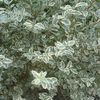
|
Ligustrum, Variegated PrivetBotanical Name: Ligustrum sinense 'Variegatum'
Variegated Ligustrum Privet (Variegated Chinese Privet), is a versatile, fast-growing shrub known for its attractive green and cream-margined leaves. It thrives in the Texas landscape, offering year-round color and adaptability to various conditions. This cultivar is particularly valued for its ability to withstand pruning, making it an excellent choice for hedges, borders, and mass plantings. While it does produce small white flowers in late spring to early summer, they are often overshadowed by its striking foliage. This variegated form of Chinese Privet is highly adaptable to different soil types and moisture conditions, tolerating everything from dry, rocky soils to wetter, low-lying areas, but still requires adequate drainage. It prefers full sun to partial shade, though the variegation is most pronounced in brighter light. It is notably heat-tolerant and drought-resistant once established, making it well-suited for much of Texas. However, in regions with extreme cold, it may experience some leaf drop. Variegated Privet is considered invasive in some regions due to its prolific reseeding. While ‘Variegatum’ is less aggressive than the green form, it should be planted responsibly in managed landscapes where spreading can be controlled. The shrub grows to about 6–12 feet tall and 6–10 feet wide, with a moderate to fast growth rate. If used as a hedge, spacing should be around 4–6 feet apart to allow for full coverage. [ More Info ]
|
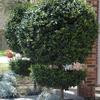
|
Ligustrum, WaxleafBotanical Name: Ligustrum japonicum 'Texanum'
Waxleaf Ligustrum (Ligustrum japonicum), also known as Wax-Leaf Privet, Japanese Privet, or even Japanese Ligustrum (which is a misnomer, more on that below) is a versatile, evergreen shrub or small tree widely used in Texas landscapes for its dense foliage and adaptability. It is often shaped into hedges, privacy screens, or small ornamental trees due to its compact growth and glossy, dark green leaves. In spring, it produces clusters of small, fragrant white flowers, followed by dark berries in fall that attract birds. This hardy plant is popular in residential and commercial landscapes due to its low-maintenance nature and ability to tolerate urban conditions. Waxleaf Ligustrum thrives in full sun to partial shade and is adaptable to various soil types, though it prefers well-draining, slightly acidic to neutral soils. It can tolerate some drought once established but benefits from occasional deep watering during extended dry periods. The flowers attract pollinators, but the berries are mildly toxic if ingested, making it a less ideal choice for homes with pets or small children. Additionally, the plant is generally deer-resistant, adding to its suitability for Texas landscapes. Reaching a mature height of 8 to 12 feet with a spread of 6 to 8 feet, Waxleaf Ligustrum is fast-growing and requires occasional pruning to maintain its desired shape. While not considered as invasive as some other privets, it does readily reseed, so periodic removal of unwanted seedlings may be necessary. Its dense growth habit makes it an excellent windbreak or sound barrier in addition to being an effective privacy hedge. To form a hedge, plant them 3 to 4 feet apart. Waxleaf Ligustrum is often confused with Ligustrum lucidum, with common names of Japanese Ligustrum, Japanese Privet, and Glossy Privet -- but they differ in several key ways. Japanese Ligustrum grows significantly taller, reaching 20 to 30 feet, and is more tree-like, whereas Waxleaf Ligustrum remains more compact and shrubby. Additionally, Japanese Ligustrum has larger, thinner leaves with a more pronounced sheen, while Waxleaf Ligustrum has thicker, more rigid leaves. Both plants produce similar flowers and berries, but Japanese Ligustrum is considered more invasive due to its aggressive reseeding and rapid spread. In winter, Waxleaf Ligustrum remains evergreen across most of Texas, though it may experience leaf damage in particularly harsh cold snaps, especially in USDA Zone 7 or colder regions. A layer of mulch around the base helps insulate the roots, and covering young plants with frost cloth during extreme cold can prevent damage. If frostbite occurs, prune any affected branches in early spring to encourage new, healthy growth. [ More Info ]
|
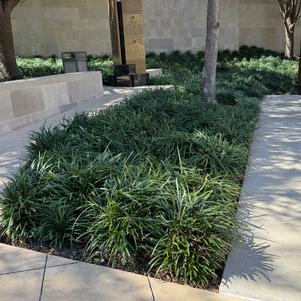
|
Liriope, Super Big BlueBotanical Name: Lirope muscari 'Super Big Blue'
[ More Info ]
|
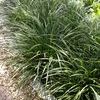
|
Lirope, GiantBotanical Name: Lirope muscari 'Emerald Goddess'
[ More Info ]
|
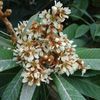
|
Loquat, Japanese PlumBotanical Name: Eriobotrya japonica
Japanese Plum Loquat is a small evergreen tree or large shrub that is highly valued for its attractive foliage, fragrant blooms, and edible fruit. Its dark green, leathery leaves provide year-round interest, while clusters of white, sweetly scented flowers appear in late fall to early winter (October to February), followed by small, golden-orange fruit in spring to early summer. This tree is an excellent choice for ornamental plantings, edible landscapes, and privacy screens in Texas gardens. Loquats thrive in full sun to partial shade and prefer well-draining soil but are highly adaptable to both acidic and alkaline conditions. Once established, they are drought tolerant but benefit from occasional deep watering, particularly during fruit production. While generally deer resistant, they may attract wildlife such as birds and small mammals that feed on the fruit. Loquats are a great addition to gardens where edible landscaping is a priority, however note the seeds do have a mild toxicity to pets. This variety grows to a mature height of 15-25 feet with a spread of 15-20 feet, forming a dense, rounded canopy. When planting multiple trees for a privacy screen or orchard, spacing of 12-15 feet apart ensures healthy growth and proper air circulation. Compared to other fruit trees, loquats are relatively low maintenance, requiring only occasional pruning to maintain shape and encourage airflow. Loquats produce small, sweet-tart fruit that can be eaten fresh or used for making jams, jellies, sauces, and desserts. The fruit ripens in spring and early summer, providing a seasonal harvest for home gardeners. With its high vitamin A content and antioxidants, loquat fruit is both nutritious and delicious, making it a valuable addition to edible landscapes. In USDA Zones 8-10, loquats are cold hardy but may suffer leaf damage or fruit loss in temperatures below 25°F. Young trees are more vulnerable to freezing conditions and should be protected with frost cloth or mulch during hard freezes. In warmer regions of Texas, they thrive with minimal winter care and produce reliable fruit crops each year. [ More Info ]
|
